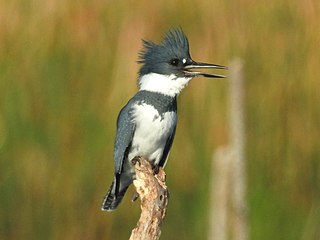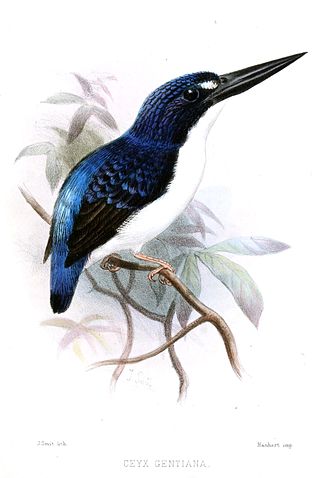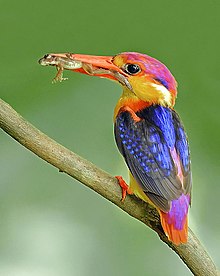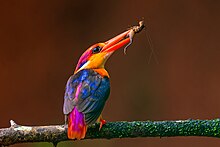
Kingfishers are a family, the Alcedinidae, of small to medium-sized, brightly coloured birds in the order Coraciiformes. They have a cosmopolitan distribution, with most species living in the tropical regions of Africa, Asia, and Oceania, but also can be seen in Europe. They can be found in deep forests near calm ponds and small rivers. The family contains 116 species and is divided into three subfamilies and 19 genera. All kingfishers have large heads, long, sharp, pointed bills, short legs, and stubby tails. Most species have bright plumage with only small differences between the sexes. Most species are tropical in distribution, and a slight majority are found only in forests.

The belted kingfisher is a large, conspicuous water kingfisher, native to North America. All kingfishers are placed in one family, Alcedinidae, and recent research suggests that this should be divided into three subfamilies.

The common kingfisher, also known as the Eurasian kingfisher and river kingfisher, is a small kingfisher with seven subspecies recognized within its wide distribution across Eurasia and North Africa. It is resident in much of its range, but migrates from areas where rivers freeze in winter.

The river kingfishers or pygmy kingfishers, subfamily Alcedininae, are one of the three subfamilies of kingfishers. The river kingfishers are widespread through Africa and east and south Asia as far as Australia, with one species, the common kingfisher also appearing in Europe and northern Asia. This group includes many kingfishers that actually dive for fish. The origin of the subfamily is thought to have been in Asia.

The green-and-rufous kingfisher is a species of "water kingfisher" in subfamily Cerylinae of family Alcedinidae. It is found in the American tropics from Nicaragua to Panama and in every mainland South American country except Argentina, Chile, and Uruguay.

The Moluccan dwarf kingfisher, formerly known as the variable dwarf kingfisher, is a species of bird in the family Alcedinidae.

Ceyx is an Old World genus of river kingfishers. These kingfishers are found from South East Asia to the Solomon Islands.

The dimorphic dwarf kingfisher is a species of bird in the family Alcedinidae that is endemic to the central and southern Philippines. Its natural habitat is subtropical or tropical moist lowland forests.

The Sula dwarf kingfisher, is a species of bird in the family Alcedinidae that is endemic to the Sula Islands in Indonesia. Its natural habitat is subtropical or tropical moist lowland forests. It was formerly considered to be a subspecies of the variable dwarf kingfisher.

The Buru dwarf kingfisher, is a species of bird in the family Alcedinidae that is endemic to Buru Island in Indonesia. Its natural habitat is subtropical or tropical moist lowland forests.

The Papuan dwarf kingfisher, is a species of bird in the family Alcedinidae that is endemic to the western Papuan islands, New Guinea, Aru Islands and the D'Entrecasteaux Archipelago. Its natural habitat is subtropical or tropical moist lowland forests.
The Manus dwarf kingfisher, is a species of bird in the family Alcedinidae that is endemic to the Admiralty Islands. Its natural habitat is subtropical or tropical moist lowland forests.
The New Ireland dwarf kingfisher, is a species of bird in the family Alcedinidae that is endemic to New Hanover Island, New Ireland and the Lihir Islands. Its natural habitat is subtropical or tropical moist lowland forests.
The New Britain dwarf kingfisher, is a species of bird in the family Alcedinidae that is endemic to New Britain and Umboi Island. Its natural habitat is subtropical or tropical moist lowland forests.

The North Solomons dwarf kingfisher, is a species of bird in the family Alcedinidae that is endemic to the west and central Solomon Islands. Its natural habitat is subtropical or tropical moist lowland forests.
The New Georgia dwarf kingfisher, is a species of bird in the family Alcedinidae that is endemic to the west central Solomon Islands. Its natural habitat is sub-tropical or tropical moist lowland forests.
The Guadalcanal dwarf kingfisher, is a species of bird in the family Alcedinidae that is endemic to Guadalcanal Island. Its natural habitat is sub-tropical or tropical moist lowland forests.
The Malaita dwarf kingfisher, is a subspecies of bird in the family Alcedinidae that is endemic to Malaita Island. Its natural habitat is subtropical or tropical moist lowland forests.

The Makira dwarf kingfisher is a species of bird in the family Alcedinidae that is endemic to Makira Island. Its natural habitat is subtropical or tropical moist lowland forests.

The rufous-backed dwarf kingfisher is a small bird in the kingfisher family Alcedinidae that is found in parts of Maritime Southeast Asia. It was formerly considered to be conspecific with the black-backed dwarf kingfisher and together the two taxa were known by the English name "oriental dwarf kingfisher".



















